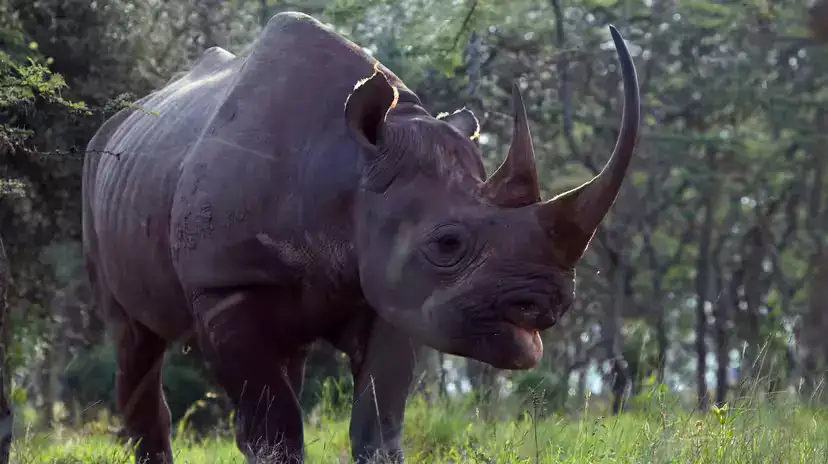Critically endangered: Fewer than 6,500 black rhinos remain due to poaching and habitat loss.
Hook-lipped browser: A prehensile upper lip lets them pluck twigs, leaves, and fruit from shrubs and small trees.
Carefully guarded comeback: Targeted anti-poaching, translocations, and habitat management have nudged numbers upward in recent years.

Species Overview
Identification & Field Marks
Range & Habitat
Diet & Ecology
Behavior & Life Cycle
Black vs. White Rhino: Quick Comparison
Conservation Status & Major Threats
What’s Working: Protection & Recovery
How You Can Help
Fast Facts
FAQs
The black rhinoceros, also called the hook-lipped rhinoceros, is one of Africa’s two native rhino species. Once widespread across the continent, it suffered a catastrophic decline in the late 20th century. Today, small, intensively protected populations persist in parts of Namibia, South Africa, Kenya, and Tanzania, with reintroduced groups in a few additional countries.
Scientific name: Diceros bicornis
Subspecies (extant):
Eastern black rhino (D. b. michaeli) – Kenya, northern Tanzania
South-central black rhino (D. b. minor) – South Africa, Zimbabwe, southern Tanzania
South-western black rhino (D. b. bicornis) – Namibia, northwestern South Africa
Subspecies (extinct): Western black rhino (D. b. longipes)
Color: Both black and white rhinos are slate-gray; color varies with local mud.
Lip shape: Pointed, prehensile upper lip (grips browse).
Horns: Two keratin horns; the front horn typically longer.
Build: Stockier than you might expect for a browser; shorter head than white rhino; no prominent shoulder “saddle” hump.
Size: Shoulder height ~1.4–1.8 m (4.6–6 ft); length ~3.3–3.7 m (11–12 ft); mass 680–1,400+ kg (1,500–3,100 lb).
Senses: Strong smell and hearing, poor eyesight.
Temperament: Generally solitary; can be reactive when surprised at close range.
Black rhinos favor arid and semi-arid savannas, thorn scrub, and mopane/acacia shrublands with a mosaic of browse, shade, and water. They rely on dense thickets for cover and mineral licks for micronutrients.
Elevation: Sea level to ~2,700 m depending on region.
Home range: Highly variable—smaller in browse-rich, well-watered habitats; larger in arid zones.
Feeding guild: Browser (leaves, shoots, twigs, forbs, fruits, succulents).
Adaptations: Hooked lip for fine picking; strong neck/jaw muscles to snap stems; robust gut for tannin-rich plants.
Daily rhythm: Crepuscular/nocturnal peaks in hot weather; rests in shade or mud wallows by day.
Ecosystem role: Vegetation engineer—pruning shrubs, opening browse layers, dispersing seeds in dung.
Social system: Mostly solitary; loose overlap at waterholes or mineral licks.
Territory: Adult bulls hold and patrol territories; overlapping female ranges.
Communication: Dung middens, urine spraying, glandular scents; grunts, snorts, and squeals at close range.
Reproduction:
Gestation: ~15–16 months
Calf: 1 (calving interval ~2.5–4 years)
Maternal care: Calf remains with the cow 2–4 years
Longevity: 30–40+ years in the wild (longer under care)
| Feature | Black Rhino (Diceros bicornis) | White Rhino (Ceratotherium simum) |
|---|---|---|
| Upper lip | Pointed, prehensile (browsing) | Broad, square (grazing) |
| Body size | Smaller, more compact | Larger, longer head; heavier |
| Shoulder hump | Modest | Pronounced muscular hump |
| Preferred food | Shrubs, trees, forbs | Grasses |
| Grouping | Mostly solitary | Often small groups |
| IUCN status | Critically Endangered | Near Threatened (Southern subspecies) |
Status: Critically Endangered (global population < 6,500)
Primary threats:
Poaching for horn (luxury/medicinal markets)
Habitat loss/fragmentation (agriculture, fencing, invasive plants, drought)
Small-population risks (low genetic exchange, skewed sex ratios)
Human–wildlife conflict (fence breaks, crop or water point competition)
High-intensity protection zones (HIPZ): Armed ranger units, K9 teams, rapid response, aerial surveillance.
Intelligence-led enforcement: Cross-border investigations to disrupt trafficking networks.
Translocations & meta-populations: Moving founder groups to secure, well-fenced conservancies to seed new populations and increase gene flow.
Demand reduction: Public campaigns and legal reforms to deter horn consumption.
Community conservancies: Revenue-sharing (tourism, jobs) aligns local incentives with rhino survival.
Veterinary support: Calf rescues, snare removal, treatment; strategic dehorning in some high-risk sites to deter poachers (mixed evidence, site-specific).
Recent trend: With sustained protection, annual growth rates of ~3–5% are achievable in well-managed sites.
Support credible NGOs running rangers, K9 units, and community conservation.
Choose responsible safari operators that fund protection and avoid disturbance.
Advocate for strong wildlife crime penalties and demand-reduction policies.
Avoid purchasing any wildlife products that could fuel illegal trade.
Nickname: Hook-lipped rhinoceros
Calf mass at birth: 30–45 kg (66–99 lb)
Top speed: Brief sprints up to ~55 km/h (34 mph)
Vision vs. scent: Poor eyesight; exceptional smell and hearing
Dung middens: Communal “notice boards” for local rhino communication
Q: How does habitat loss hurt black rhinos?
A: It shrinks and fragments browse-rich landscapes, reducing food, water access, and safe movement corridors—making rhinos easier targets for poachers and raising conflict with people.
Q: What traits define a black rhino?
A: The prehensile upper lip, two keratin horns, solitary nature, reliance on shrubs/trees for food, and heavy use of scent-marking for communication.
animal tags: black rhinoceros
We created this article in conjunction with AI technology, then made sure it was fact-checked and edited by a Animals Top editor.